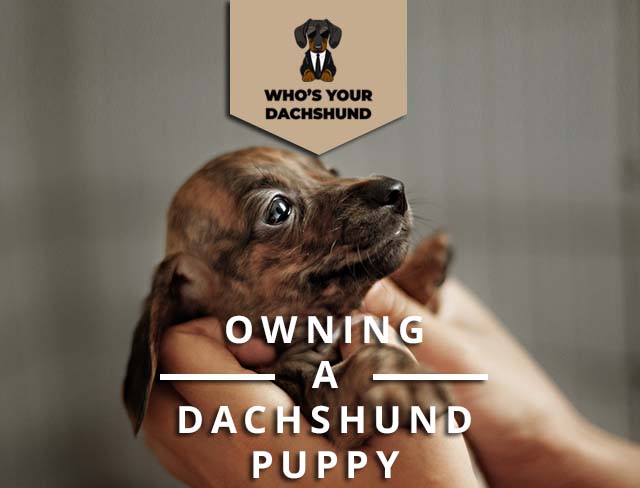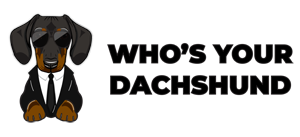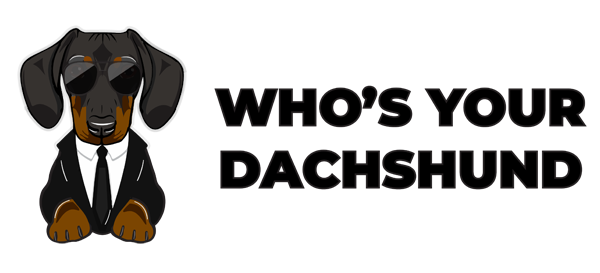
There are many great dog breeds, but if you’re looking for a great pet that’s not too large and energetic or too hyperactive, then the Dachshund might be perfect. ‘Dachs’ is German for badger, and Dachshunds are frequently irritated by and off-putting to badgers. Another stereotype is that they are sausage dogs, but this is not true. Dachshunds are short-legged dogs with long legs like a longhaired wolfhound and an elongated body like a greyhound. A characteristic pointy muzzle is also very distinctive. The number of puppies that a female Dachshund can have in her life depends on what breed she is.
Owning a Miniature Dachshund
The miniature Dachshund is a small dog breed Dachshund that weighs 12 to 18 pounds and stands 10 to 11.5 inches at the withers, making it the smallest of the Dachshund breed.No wonder why the miniature Dachshund is the most popular Dachshund breed.
The miniature Dachshund is a robust dog breed that forms a strong bond with his family and is energetic. Even though the miniature Dachshund loves playing around with his favorite toys, he also loves to cuddle up on your lap and watch TV with you. Because of this, the miniature Dachshund makes a great companion dog, mainly because they can be easily trained.
Micro mini Dachshund information
Micro mini Dachshunds are small-sized dogs, typically weighing less than 1kg. Some people can also call them toy Dachshunds or miniature Dachshunds, but the size is not everything.
Micro mini Dachshunds are among the oldest breeds of Dachshunds and were developed in Europe for small game hunting. It also hunted rabbits, rats, and larger small animals that other larger breeds of dogs would also hunt.
It has a smooth coat, and at the beginning, it was not standardized to be this short at all. It was the fashion that made the breeders shorten its coat.
Are Dachshunds Good Dogs?
Dachshunds are generally considered to be the best dogs. They’ve been bred as hunting dogs, but they are also used as police and rescue dogs. Dachshunds were also bred to hunt badgers, so they’ll hunt anything. Some families raise them as watchdogs, but they are generally considered unsuitable for that job because of their friendliness to strangers.
Are Dachshunds Good Pets?
The Dachshund is a great pet to have. These dog breeds are very social, and they love to give hugs and kisses. If you are looking for a dog that will go on walks with you, the Dachshund is a great choice. The Dachshund loves to be outside, and they are also able to spend a few hours inside your house while they will curl up on your feet or under the couch. On the other hand, Dachshunds are not the best pets for everyone; they have particular needs. They are a breed of dog that is good at hunting, and they need a lot of exercise. People who don’t want to take their dogs running every day should consider a different dog type for themselves.
The Best Dachshund Breed for You
The Dachshund is a medium-sized, shorthaired Dachshund breed of the hound family. They are generally bred to be hunting dogs. Since then, their name is German for badger dogs since they were initially bred to hunt badgers in their caves, but they have also been bred as a general hunting dog.
The Dachshund is a member of the hound group. The breed was developed to hunt badgers and other burrowing animals, with a short face and long body to fit into badger burrows.
The Dachshund is available in two sizes: standard and miniature. Standard Dachshunds are the most common and may weigh anywhere from 15 to 30 pounds. The proper weight of miniature Dachshunds weight is 6 to 12 pounds and maybe as long as 15 inches. And the healthy weight of Standard Dachshunds ranges from 16 to 32 pounds. Standard Dachshunds vary in color from shorthaired red, black, and tan (known as “liver”) to all-black. They have the typical hound dog facial features: a long, somewhat pointed muzzle; floppy triangular ears (not always seen), with dark eyes and nose. The Dachshund lives an average of 13-15 years.
What are the two types of Dachshunds available?
There are two types of Dachshunds to choose from: the smooth-haired and the longhaired. The longhaired Dachshund is more suitable for colder climates, while the smooth Dachshunds are more suitable for warmer climates. There is a chance the longhaired Dachshund can live in a hotter climate if it is groomed regularly. The longhaired Dachshund requires more grooming than the shorthaired. It needs brushing twice a day, and professional grooming is recommended once a month. You should regularly check their legs, tail, and ears for ticks and ear mites. The smooth coat should be brushed weekly, although this can vary depending on the dog’s activity level.
Do Long, Smooth, and Wire Haired Dachshunds Have Different Personalities?
Different personalities? In general, yes. Longhaired Dachshunds are more laid back and docile than their short or wire-haired counterparts. A longhaired Dachshund stands a good chance of being a mellow dog. Many times, in their early years, it isn’t easy to get them to run or play with the same energy level as a shorthaired Dachshund. I have had three wire-haired and one longhaired. For the most part, the wire-haired were more energetic than my longhaired. My youngest longhaired is MUCH more energetic than any of my others. He likes to run and play with his toys.
The Wire-Haired Dachshund
The wire-haired Dachshund is often known as the “Hugh Hefner Dog” bundle of energy. He has that cute, lovable face with a strong jaw and large bones. Usually, he weighs between 16 to 24 pounds (depending on the bloodline). This dog is very athletic, and most have deep voices. They are excellent watchdogs and will alert you to anything unusual. He is very machine-like when it comes to hunting. He is also a great runner and will often sprint after his prey until the last moment. These dogs have a strong prey drive that may be too much for many owners. He is usually very loyal and protective, but he does not bark a lot unless there is supposed to be some reason for him to bark – such as someone breaking into your house.
You will want to know that, usually, wire-haired Dachshunds are more challenging to train than their shorthaired counterparts. That’s because they love to voice their opinion. The wire-haired Dachshund makes up for this in its drive and desire to please you. Once your dog knows what you want it to do, your pet will do it as long as it does not go against its nature. He is usually more stubborn than the shorthaired Dachshund and will need more consistency to train. If you have a budget for dog training, I would recommend putting aside a bit more for the wire-haired than the shorthaired.
The Longhaired Dachshund
The longhaired Dachshund is exceptionally laid back and docile. It weighs between 14 to 16 pounds, depending on the bloodline, and its voice is very gentle and sweet rather than deep and robust. The longhaired Dachshund makes for a great house pet and is very calm. It rarely barks, and when he does, it is usually for a reason – such as someone or something comes onto your property. Unfortunately, they can’t always tell the difference between a cat or other small critter walking past your property or someone trying to break into your home. They have a lot of energy, but it is usually not the same type of energy as the wire-haired Dachshund. I’ve had many longhaired that liked to run and play, but they never had that same “machine-like” devotion to hunting as the wire-haired. The long-hair is often more independent than the short or wire hair Dachshund, and this may be due to their ability to be left alone for long periods.
The Smooth-Haired Dachshund
The smooth-haired Dachshund is an amiable dog and gets along well with other animals. They are generally not to bark loudly, but they like to dig. It has a powerful hunting instinct and may run off to hunt if not trained correctly. They are very curious and love to explore, which may lead to them getting into things they should not. The Smooth-Haired Dachshund is intelligent but stubborn. The owner needs to be firm but gentle and consistent when training the dog. Without proper training, this breed can become disobedient and aggressive towards its owners and other animals.
Dachshund Pros and Cons
What are the benefits and drawbacks of owning a Dachshund? First, the Dachshund is a small dog breed that is easy to train. They make excellent watchdogs, and they are also loyal to their masters.
The Dachshund is not very demanding, but it requires daily exercise and at least an hour of walking per day. Dachshunds are energetic, and they can become destructive if they do not get enough exercise. So, it would help if you were prepared to include your dog in your daily activities. You should also know that Dachshunds tend to burrow if exposed to a new environment.
Pros:
- Affectionate
- Intelligent
- Loyal
- Wonderful with children
- Good with other pets
- Good watchdogs
Cons:
- High-maintenance
- Stubborn
- Short-tempered
- Dislikes cold weather
- Hoard food and objects
- Barks a lot
Dachshunds are very sensitive to the weather. They do not like cold weather or extreme temperature changes. Another thing about this pet is that they like to hoard items, especially food, so you have to keep a close watch on them when you feed them.
Dachshunds have a short temper, and they can be aggressive if provoked. You should also know that Dachshunds are prone to back injury because of their long backs and spines. They stop growing once they reach adulthood.
Importance of exercise
Lack of exercise;
It would be ideal if your Dachshund could walk freely, either independently or in a carrier. Animals that do not have a lot of exercise become lazy and overweight. The leading cause for this is that when they are not exercised, their bodies start producing more hormones than they should, resulting in obesity and other health problems.
Plenty of Exercises
It would help if you gave your dog the chance to move around and play and have exercise per day. That prevents it from developing obesity, thus keeping it healthy. Also, it would be best if you treated it for fleas regularly. During summer, you may want to keep your dog outdoors in a fenced-in area where it can play and socialize with other animals.
Dogs that are not given any form of exercise become moody, and they can develop aggressive behavior and even attack their masters or themselves if given a chance.
There are several types of training for Dachshunds.
Dachshunds need to be trained, but they can be subjected to several training types. One type of training is called “positive reinforcement training.” This type of training aims to “reinforce” a particular action as positive, such as the dog obeying a command. The next type of training is called “negative reinforcement.” Negative reinforcement occurs when the master gives the dog a treat or something positive for doing something that he/she wants to be done. The third kind of training is called “positive punishment.” This procedure involves giving the dog a treat or something pleasant when he does not obey a command. Another form of training is called “negative punishment.” Negative punishment is used to punish unwanted behaviors, such as aggression. However, it is not wise to punish the dog heartlessly, as it may cause it to dislike commands in the future.
Potty training
Potty training for a Dachshund is a lot easier than most dog breeds. You do not need to spend much effort to get your Dachshund housebroken or rabbit trained.
Potty-trained dogs are happy dogs. Most dogs that are not potty trained spend a lot of time, and often their entire day, trying to hold it in. Not only is this stressful for the dog, but it is also stressful for the owner because he or she has to take the dog out every hour on the hour.
Consistent training with reward-based methods is best for dogs. If you do not use this method, your dog will likely have issues with going potty in the house when you are not there. A reward-based training system is simple; you click and treat when your dog goes potty. Start with only one command (e.g., “potty”), and as the dog’s vocabulary grows, expand to multiple commands such as “sit,” “leash,” or “stay.
Crate training
Crate training is vital for Dachshunds. A crate is where the Dachshund can go when tired or play it out a bit. If the dog is not feeling well, place them in its crate to feel better. Chasing a rabbit or squirrel that got in the yard is one thing, but chasing after your dog will result in an upset puppy and possible injury to your dog. A proper training crate is not a cage, and many great crates are available on the market.
Take your Dachshund for walks as often as possible. That can be done in the neighborhood or a local park, depending on how secure you feel about your dog’s behavior with other people and dogs. A good exercise regimen will help your dog stay healthy and improve its overall temperament.

